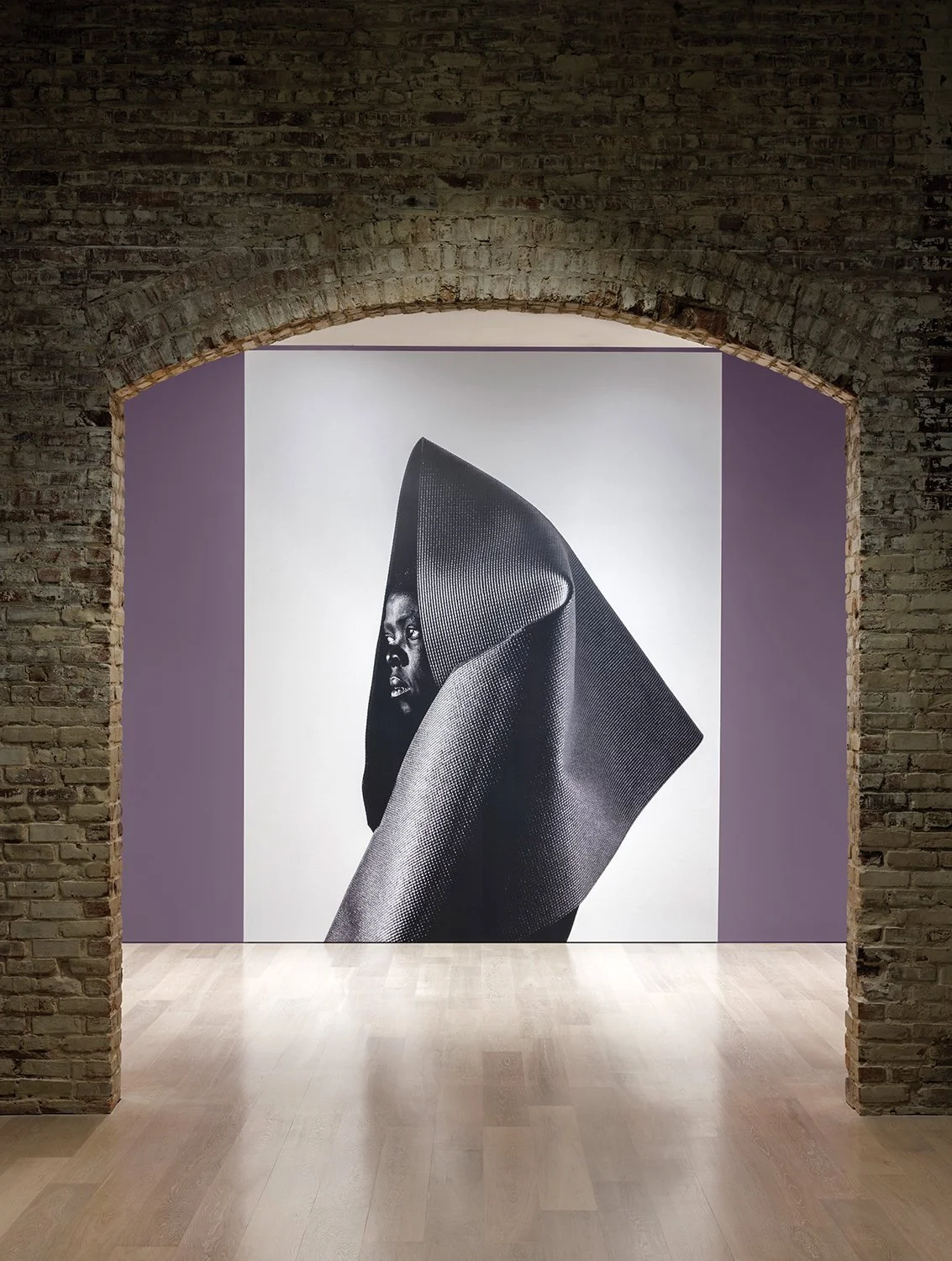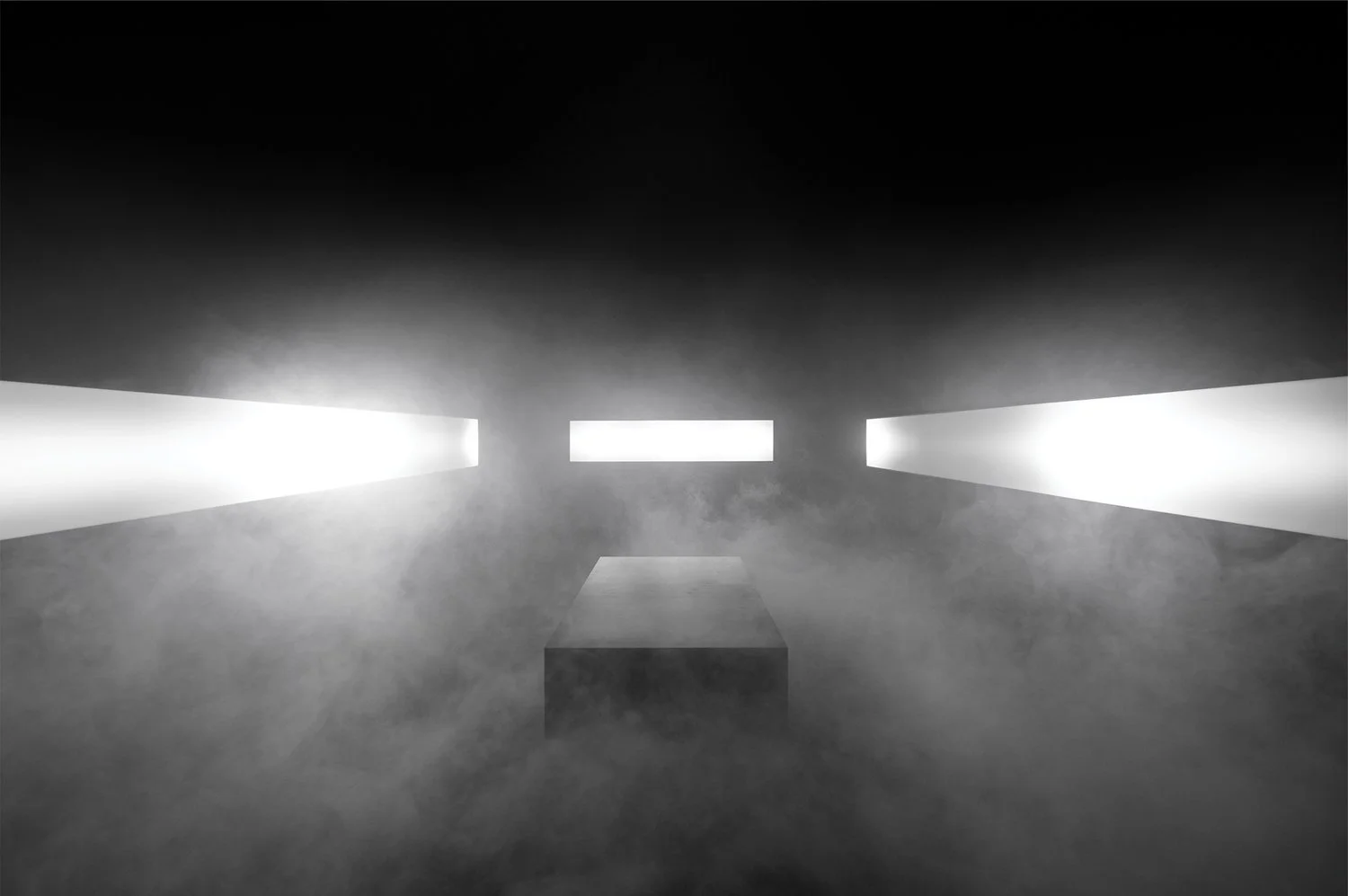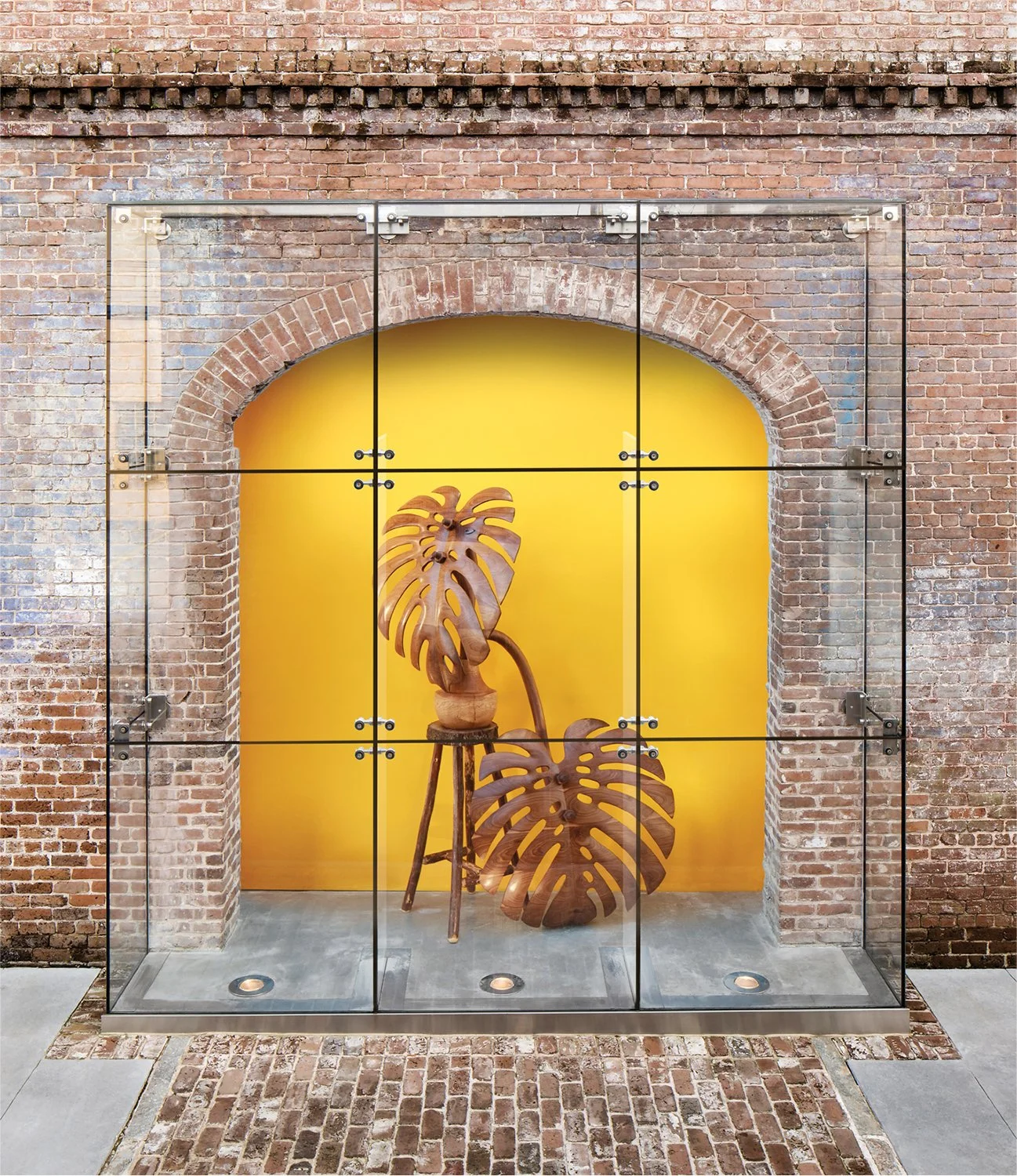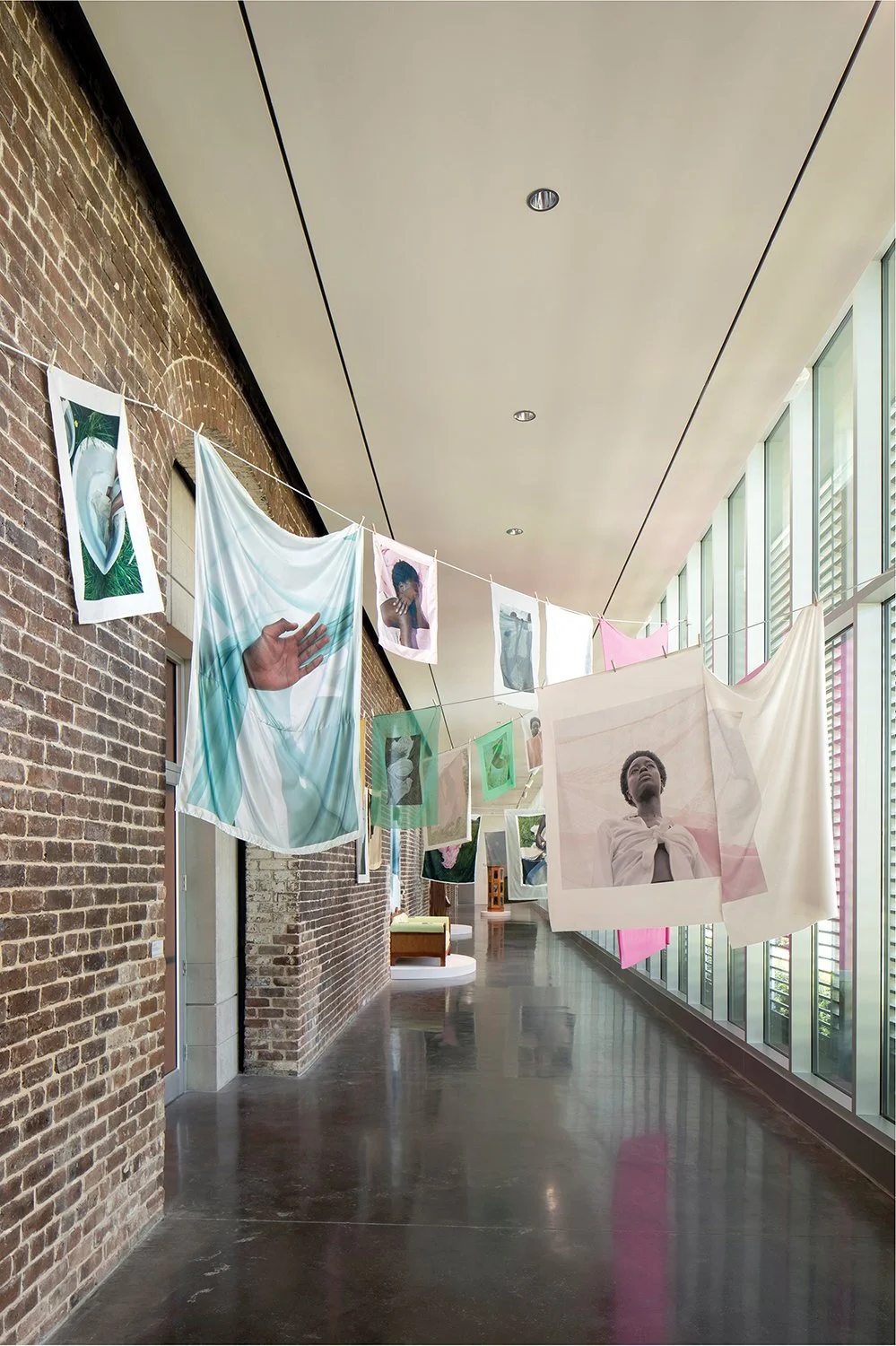Photo by Marcus Morris
Daniel S. Palmer is the Chief Curator of the SCAD Museum of Art, where he leads the museum’s curatorial vision and oversees major exhibition programs, including the annual deFINE ART series. Before joining SCAD MOA, Palmer held curatorial positions at Public Art Fund, the Jewish Museum, and the Whitney Museum of American Art. His work spans public and institutional contexts, and consistently centers artists whose practices reflect the complexities of contemporary life.
deFINE ART 2025 is a remarkable constellation of exhibitions by international and emerging artists working across photography, sound, textiles, installation, design, and painting. Anchored by the powerful presence of honoree Zanele Muholi — whose work as a visual activist offers an unflinching call for visibility and human dignity — the lineup also includes sensory installation by Jónsi, lyrical abstraction by Christina Quarles, the material and poetic brilliance of Diedrick Brackens, bold interventions by Dr. Samuel Ross, and resonant works by artists like Ken Gun Min, Raul de Lara, Sarah Crowner, and SCAD alum William Glaser Wilson. Together, these exhibitions unfold as distinct but interconnected expressions of identity, presence, and radical possibility.
In our conversation with Daniel, he reflects on the evolution of his curatorial practice, the collaborative nature of exhibition-making at SCAD MOA, and the changing role of museums in fostering dialogue, accessibility, and cross-disciplinary engagement.
IMPACT: Your career has spanned across public art, independent projects, and museum curation. How has your approach to curating evolved over time, and how do those earlier experiences influence your work on ‘deFINE ART 2025’?
Daniel S. Palmer: First off, I’ll say how great it is to be chatting with you. I really admire the work that IMPACT has been doing for the arts in our community, and I have been grateful for the ways the magazine has so thoughtfully engaged with our exhibitions at the SCAD Museum of Art!
Zanele Muholi, presented as part of SCAD deFINE ART 2025. Photo courtesy of SCAD Museum of Art
To answer your question, I first came to curating art through art history. I was lucky to have the opportunity to take an AP Art History course during my senior year of high school when I was really a bit lost and unsure of my path forward. For a while I thought I was going to teach art history, but getting to know such amazing artists while I was studying for my doctorate at the CUNY Graduate Center helped me realize that I could be a part of art history myself and still pedagogically focused by sharing their incredible work with the public. My earliest museum jobs – first as a curatorial research assistant at the Whitney Museum of American Art and then as an assistant curator at the Jewish Museum helped me understand the opportunities possible for work as a curator in a museum and enabled me to leverage institutional platforms to showcase the art that I felt was important to advocate for as a reflection and incitement for our times. Then, my time at New York’s Public Art Fund curating large-scale public art installations was a wonderful role that really honed my interest in sharing art with wider audiences, especially those who might be coming to art for the first time. My belief that art should be accessible to everyone and that it can change the world is a core tenet that drives everything I do. The opportunity to serve as the chief curator here at the SCAD Museum of Art is truly a dream come true. SCAD is all about inspiring the next generation in ways that are groundbreaking and accessible. The museum is the best of all worlds and the exhibitions we have been able to organize here feel like they reflect this ethos.
IMPACT: Curating ten new exhibitions for deFINE ART means balancing individual artistic voices while crafting an overarching narrative. What are some of the guiding principles you use when shaping an exhibition of this scale?
DSP: Everything we do at the SCAD Museum of Art is focused on sharing the most interesting, important, inspiring artists with the SCAD students, wider Savannah community, and visitors to our wonderful city. That is a pretty great guiding principle to abide by, and it means that deFINE ART is a very impactful moment for us to inaugurate ten new exhibitions that do exactly that. This year’s edition is a tour de force – Rising star William Glaser Wilson in our Alumni Gallery, Vera & Friends with silk scarves and artworks by Vera Neumann and Massif Central (newly gifted to the collection) in our lobby, Raul de Lara’s first solo museum presentation in our “jewel box” vitrines, numerous new weavings by Diedrick Brackens in the Walter and Linda Evans Center for African American Studies gallery, a focused exhibition of Christina Quarles’ drawings and paintings on paper, Dr. Samuel Ross’ first US museum solo exhibition in our André Leon Talley Gallery, beautiful paintings by Ken Gun Min, a transformative immersive installation by Jónsi, Sarah Crowner’s longest tile platform to date, and of course a breathtaking survey of our honoree, Zanele Muholi. As I see it, each show fits together like a dinner party. They are unique, yet they offer compatible dialogue from one to the next. We always consider the exhibition season holistically, and organize the grouping in keeping with SCAD’s focus on global diversity and also a diversity of media. Showing painting, photography, sculpture, fashion, design, installation, even sound art or video art, allows us to give a broad survey of the most interesting and vital currents in contemporary art at any given moment. SCAD is such an interdisciplinary and dynamic institution – it is so forward looking and future oriented – so it feels great to reflect that in our exhibition program.
Ken Gun Min, Night Cruiser (Westlake), 2023. Korean pearl pigment, silk embroidery, oil on canvas, 50 x 41 inches
On display in The vastness is bearable only through love SCAD deFINE ART 2025. Courtesy of SCAD Museum of Art
IMPACT: How do you design an exhibition experience that remains intellectually and emotionally engaging for both art-world insiders and those encountering contemporary art for the first time?
DSP: Equal consideration of art-world insiders and new audiences is a central component of our work here at the SCAD Museum of Art. I’m really heartened to know that there are many visitors to this museum who may be entering a museum for the first time. It’s such an incredible opportunity to make everyone feel welcome and inspired. I hope it sets in motion a realization that art is essential to a life well lived! Likewise, I also know that we have some very savvy audience members who are art world insiders, and that anyone who walks through our gallery doors could have written a thesis or book on one of the artists we’re exhibiting. That is exactly why I have always thought it is so important to include entry points to art that are accessible, but never dumb things down. I’m really insistent that each of our exhibitions should have text about the work, and we make sure that our student docents are well-informed about the shows. I really can’t speak highly enough about our student docents! They are the most thoughtful, generous, eloquent team from so many different backgrounds. They are the best advocates for the art and provide wonderful insights for every type of audience who visits the museum. Seriously, next time you visit, ask them to share a bit about the art and they will provide such personal perspectives about what it means to them.
IMPACT: The museum experience is changing, with more emphasis on sensory engagement and interactivity. How do you see the role of the curator evolving in response to this shift?
DSP: That’s absolutely true. We generally have ten exhibitions on view and sometimes visitors walk out of the museum saying they saw the whole museum in just ten minutes. That always baffles me, but I think video art and immersive experiences may help with that. As much as I love close looking and can sit in front of a painting for hours, I know that’s not the case for everyone and that technology has really sped up the pace of life and how we interact with art especially. However, that can also be an opportunity. I have no problem with moments in exhibitions that encourage people to take out their phones to take a picture of the art or even a selfie. I view that action as an expression of interest, and anything that deepens engagement with art, beauty, ideas, and other cultures feels like a win in my book. I’ve been talking with our curatorial team here at the museum (huge shoutout to Ben Tollefson, Brittany Richmond, and Haley Clouser!) that our focus on various media can be a real asset when it comes to the pace that visitors experience the museum. Video exhibitions like those recently from Monira Al Qadiri (2024), Cao Fei (2024), Mika Rottenberg (2023) or interactive experiences like those by Danielle Brathwaite-Shirley (2023), and of course our current show by Jónsi certainly address this opportunity. Someone might run through a gallery of paintings, but maybe a video or immersive experience might slow them down a bit, and big installations or exhibitions with hundreds of artworks certainly will as well. So, it’s ultimately about variety as a way to assure that there is something for everyone. I think we need to be receptive to different perspectives and everyone’s unique positions in the world. It also feels funny to say it, but a good bench and accommodating lighting is really great at helping us slow down a bit and soak up the experience too.
Installation view of Monira Al Qadiri, Holy Quarter at SCAD Museum of Art, 2024
IMPACT: What do you wish people understood better about curating?
DSP: I think a lot about how every decision a curator makes is a form of communicating something to the audience. Literally everything you see in a museum could have been some other way. There may be conventional standards about how high an artwork is hung (60” on center), wall colors (white), institutional voice in didactic texts (authoritative), etc., but none of that absolutely has to be that way. It might be a bit overwhelming to think about all of these choices en masse, but I absolutely love to consider each and discuss with my colleagues and with the artists we work with how we can make adjustments that enrich the audience’s experience of the art. Hopefully these choices make the exhibition a powerful, dynamic experience that presents the artist’s vision for their art in the best way possible.
IMPACT: What advice would you give an aspiring curator?
DSP: You can do it, however and wherever you’d like. Don’t be bound by inherited assumptions about how any of it is supposed to be done. We need new approaches and diverse voices! An art museum is only one of many potential venues to share art. An aspiring curator shouldn’t be limited by expectations and the conventional wisdom of tradition and history. An exhibition can happen anywhere and the form isn’t set in stone. Bootstrap! Additionally, the best thing about being an aspiring curator is that there are so many wonderful artists who are looking for opportunities to share their work that you can help facilitate in creative ways. Maybe the best thing I can say to aspiring curators is to find someone whose art you are genuinely interested in, get to know them better as a person, consider what insights you can offer to the world, and dream up a creative way to share them.
IMPACT: What is the most important thing a curator can do for an artist?
DSP: I try to approach every opportunity I get as a truly precious chance to learn from artists what they are hoping to communicate through their art. Artists put so much of themselves into their art – it is so precious, fragile and intimate. It is such a privilege when artists open up and share. When someone entrusts their creativity with me, I view it as an immense honor to act in service of their creation and gift. I believe that curators should assume a sense of duty and responsibility to help facilitate imparting the magic of art with as wide a public in the most impactful way possible.
Zanele Muholi, presented as part of SCAD deFINE ART 2025. Photo courtesy of SCAD Museum of Art
IMPACT: Zanele Muholi’s work is deeply rooted in advocacy, visibility, and representation. How do you approach curating an exhibition that carries such an important social and cultural message while allowing space for the viewer’s personal engagement?
DSP: The SCAD Museum of Art aims to inspire individuals from all backgrounds and I have always found that the wider the scope of individuals who feel welcome and seen in a museum, the better benefit for the entire world. I know that sounds grandiose, but I deeply believe it. Unfortunately, far too often many people have felt excluded or not welcome in museums – what a travesty, but also what an opportunity to rectify this problem and address critical issues of our era. I am profoundly moved by how Zanele Muholi considers their work as a “visual activist” and I find their striking photographs so powerful. The portrait subjects and self-portraits look out at audiences with a resolute directness that is simultaneously bold, empowered, and embracing. I am truly heartened by the response and how much people have told me that they see themselves in this work here.
IMPACT: Jónsi’s practice moves beyond traditional visual art into sensory realms — sound, fragrance, and touch. What challenges and opportunities arise when curating work that is not just seen, but physically and emotionally felt?
DSP: The SCAD Museum of Art isn’t your typical museum, so of course Jónsi’s Vox installation is a perfect fit for us. We have a really vibrant range of studies and majors here at the university that resonate with this exhibition, in particular: SCAD’s Sound Design program as well as our Business of Beauty and Fragrance degree. Those students and so many others have been absolutely plugged-in to this exhibition in ways that are reflected in their education. I also love the way that Jónsi’s art is so multi-dimensional and really attunes audiences to senses that maybe they don’t consider as frequently in their everyday life. Beyond that, the space Jónsi has created is meditative and profoundly centering. You might occasionally find me there taking a little pause in between meetings on a hectic day.
Jónsi, Vox, SCAD deFINE ART 2025. Courtesy of SCAD Museum of Art
IMPACT: Did curating this selection of artists reveal new thematic or material connections that weren’t initially obvious? How do you encourage these cross-artist conversations within the exhibition space?
DSP: My favorite thing about the SCAD Museum of Art opening ten exhibitions at the same time is that there are always beautiful connections that happen across the various shows. Some of them are planned and others surprise us or arise naturally from sustained contemplation across the experience of the shows. The gallery spaces set those dialogues up because the historic railroad warehouse structure of the museum positions one exhibition after the next, solely delineated by the historic Savannah Grey Brick archways. Some people speak of the ten exhibitions almost as a single entity, maybe akin to a biennial or large group show. I love that each artist’s world exists on its own terms but in dialogue with the others on view. In the case of our deFINE ART 2025 season, it feels like all of the exhibitions are very generous, inclusive, poetic, yet powerfully responding to the moment we live in, with all of its complexities. Ultimately, I would say they are all full-throated articulations of powerful worldviews by each artist, and unflinchingly optimistic.
IMPACT: deFINE ART extends beyond the museum walls with artist talks, performances, and panel discussions. How do these events enhance the exhibition experience, and what kinds of conversations do you hope they inspire?
Installation view of Raul De Lara: Raíces/Roots at SCAD Museum of Art, SCAD deFINE ART 2025
DSP: The other activations we organize for our deFINE ART week are some of the best parts of our programming, which people tell me they look forward to each year. The artists’ visits to Savannah are so inspiring in many ways. Their public talks provide the general public with an opportunity to gain additional insights and to hear from the artists about their exhibitions. The class visits, masterclasses, and other special events we organize are truly life-changing for our students because that level of access and dialogue really doesn’t happen anywhere else. I hope that the pearls of wisdom the artists impart to the students will inspire future generations, and I know for certain that the artists are equally inspired by their experiences here at SCAD. They always tell me that!
IMPACT: As deFINE ART evolves, are there particular artistic movements, mediums, or global perspectives that you hope to bring into future iterations of the program?
DSP: We always aim for true global diversity and media diversity in our program. That is such a natural fit with SCAD’s student population and how an interdisciplinary approach to learning and creation is a central part of what our students do. We have become a museum that is focused on highlighting the most vibrant contemporary art to inspire the future global creatives here. I find it so meaningful and enlightening to learn from our students the direction of the future, and always try to consider how it aligns and dovetails with the newest currents and innovations in contemporary art. That aspect is reflected in the SCAD Museum of Art’s incredible history of curating the first museum exhibition or first museum exhibition in the USA with an artist who goes on to achieve enormous success and shape the direction of art and culture. Some great examples that come to mind are: the first solo museum exhibitions for Chase Hall (2023), Awol Erizku (2024), Anna Park (2022), Yu Ho Hong’s first solo museum exhibition in the USA (2023), Holly Hendry’s first solo museum exhibition in the USA (2024), Tyler Mitchell’s first solo museum exhibition in his home state of Georgia (2024), etc.!
IMPACT: What was the last show that you traveled to see?
Installation view of Tyler Mitchell’s Domestic Imaginaries, 2023. Photo courtesy of SCAD Museum of Art
DSP: I was just up in New York City to see some great exhibitions: Tyler Mitchell’s Ghost Images (his 2023 Domestic Imaginaries exhibition at SCAD MOA is still very dear to me); Sara Charlesworth’s Desire and Seduction; Ericka Beckman’s Power of the Spin; and Dor Guez’s Unfolding Negatives. All were truly superb.
IMPACT: What upcoming exhibitions (outside of SCAD) are you most excited about?
DSP: My dear friend Ann Craven will have a series of concurrent exhibitions at important museums in Maine this summer. (Her Twelve Moons exhibition at SCAD MOA in 2022 was such a special collaboration.)
IMPACT: What is one exhibition that inspired you?
DSP: My visit to the 1993 Whitney Biennial as a kid was pretty mind blowing. So were Matthew Barney’s The Cremaster Cycle at the Guggenheim (2003) and the Martin Creed exhibition at the Fondazione Nicola Trussardi in Milan (2006). On the historic side, the Louvre’s recent Pierrot, dit Le Gilles, de Watteau: Un comédien sans réplique (2024) exhibition moved me to tears (not such an uncommon occurrence for me with Watteau paintings, I’ll admit).
IMPACT: What is the best piece of criticism that you read recently?
DSP: I recently read an incredible book of essays and criticism by Salman Rushdie, and also Arundhati Roy’s My Seditious Heart. They both make me want to write better and more, to share with the world.
IMPACT: Are there particular ideas that are inspiring your practice now?
DSP: Yes! Gratitude, authenticity, honestly expressing genuine enthusiasm – “love it, know it.”
###












